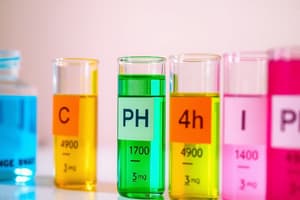Podcast
Questions and Answers
What is the purpose of using indicators such as litmus and phenolphthalein in testing solutions?
What is the purpose of using indicators such as litmus and phenolphthalein in testing solutions?
- To neutralize the acid or base in the solutions
- To identify whether the solution is acidic or basic based on color change (correct)
- To enhance the odor of the solutions
- To determine the concentration of the solutions
Which of the following acids is NOT mentioned as part of the laboratory activity?
Which of the following acids is NOT mentioned as part of the laboratory activity?
- Acetic acid
- Hydrochloric acid
- Phosphoric acid (correct)
- Nitric acid
What type of indicator is commonly used for testing acid and base solutions through a change in odor?
What type of indicator is commonly used for testing acid and base solutions through a change in odor?
- Phenolphthalein
- Litmus
- Methyl orange
- Olfactory indicators (correct)
What process would you use to identify the acidic or basic nature of substances using onions?
What process would you use to identify the acidic or basic nature of substances using onions?
Which chemical reaction is associated with the release of energy from food in cells?
Which chemical reaction is associated with the release of energy from food in cells?
What is the main role of chloroplasts in relation to food?
What is the main role of chloroplasts in relation to food?
Which of the following substances is classified as a base?
Which of the following substances is classified as a base?
What might be a consequence of not maintaining the life processes within an organism?
What might be a consequence of not maintaining the life processes within an organism?
What is the primary function of nutrition in organisms?
What is the primary function of nutrition in organisms?
What is a consequence of increased body size in multicellular organisms?
What is a consequence of increased body size in multicellular organisms?
Which chemical reactions are primarily involved in breaking down molecules in organisms?
Which chemical reactions are primarily involved in breaking down molecules in organisms?
How do multicellular organisms acquire oxygen for metabolism?
How do multicellular organisms acquire oxygen for metabolism?
Why is simple diffusion insufficient for nutrient distribution in large multicellular organisms?
Why is simple diffusion insufficient for nutrient distribution in large multicellular organisms?
What must happen to food sources before they can be utilized by the body?
What must happen to food sources before they can be utilized by the body?
What structures are commonly needed by multicellular organisms for gas exchange?
What structures are commonly needed by multicellular organisms for gas exchange?
What role does oxygen play in the context of energy transfer for organisms?
What role does oxygen play in the context of energy transfer for organisms?
Flashcards
Nutrition
Nutrition
The process of transferring energy from food (external source) to the internal environment of an organism.
Oxidizing reactions
Oxidizing reactions
Chemical reactions that break down molecules by removing electrons. These reactions are essential for extracting energy from food.
Reducing reactions
Reducing reactions
Chemical reactions that add electrons to molecules, allowing for the building up of complex molecules.
Respiration
Respiration
Signup and view all the flashcards
Direct exchange in single-celled organisms
Direct exchange in single-celled organisms
Signup and view all the flashcards
Transport challenges in multicellular organisms
Transport challenges in multicellular organisms
Signup and view all the flashcards
Specialized tissues in multicellular organisms
Specialized tissues in multicellular organisms
Signup and view all the flashcards
Transport of food and oxygen
Transport of food and oxygen
Signup and view all the flashcards
What are indicators?
What are indicators?
Signup and view all the flashcards
What are olfactory indicators?
What are olfactory indicators?
Signup and view all the flashcards
What are carbon molecules in relation to food?
What are carbon molecules in relation to food?
Signup and view all the flashcards
What is oxidation-reduction in relation to food?
What is oxidation-reduction in relation to food?
Signup and view all the flashcards
What is simple diffusion?
What is simple diffusion?
Signup and view all the flashcards
What is photosynthesis?
What is photosynthesis?
Signup and view all the flashcards
What is respiration?
What is respiration?
Signup and view all the flashcards
What are life processes?
What are life processes?
Signup and view all the flashcards
Study Notes
Chemical Properties of Acids and Bases
- Activity 2.1: Collect various solutions (acids and bases) and test them with red litmus, blue litmus, phenolphthalein, and methyl orange.
- Table 2.1: Record the colour changes observed for each solution with each indicator.
- Indicators: Red litmus, blue litmus, phenolphthalein, and methyl orange are used to identify whether a substance is acidic or basic. Colour changes indicate the nature.
- Olfactory Indicators: Certain substances change odour in acidic or basic media.
Nutrition and Life Processes
- Maintenance: Life processes maintain the body's function in all life stages.
- Energy and Raw Materials: Life processes require energy and raw materials from outside the body. Energy is needed for physical and biological processes. Raw materials for growth are also needed.
- Food Sources: Food sources vary. Carbon-based molecules are common.
- Complexity of Organisms: Different organisms use different nutritional processes based on food source complexity.
- Respiration: The process used by organisms to acquire oxygen and break down foods.
- Single-celled Organisms: Nutrients, oxygen and waste removal occur directly through the surface of the cell.
- Multi-celled Organisms: Specialised tissues and organs are needed to acquire nutrients, oxygen, and manage waste.
- Transportation: Multi-cellular organisms need a system to transport substances (e.g., nutrients, oxygen) to all cells.
- Excretion: Removal of waste products that are useless or harmful in a multi-cellular organism.
Studying That Suits You
Use AI to generate personalized quizzes and flashcards to suit your learning preferences.
Related Documents
Description
This quiz explores the chemical properties of acids and bases, focusing on their reactions with various indicators such as litmus and phenolphthalein. Students will learn to identify the nature of substances through color changes and the role of olfactory indicators. It also touches on nutrition and life processes that support these chemical interactions.




